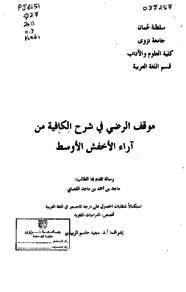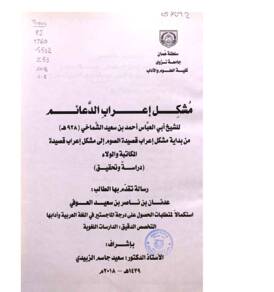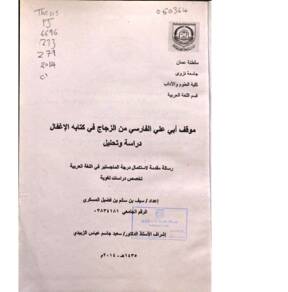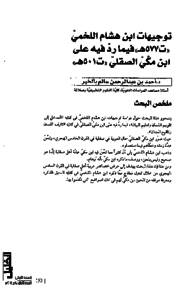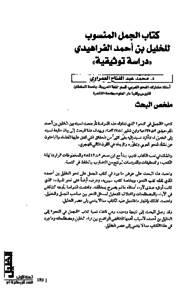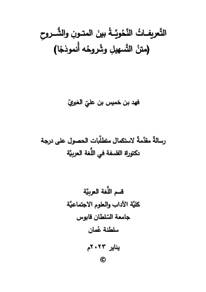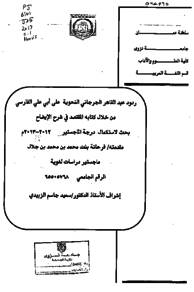وثيقة
موقف الرضي في شرح الكافية من آراء الأخفش الأوسط.
الناشر
جامعة نزوى.
ميلادي
2011
اللغة
العربية
الموضوع
الملخص الإنجليزي
This study highlights Al-Radhi's attitudes in his book "Sharh AL-Kafia" towards AL-Akhfash ALAwsat' opinions. It illustrates ninety-four issues in which AL-Radhi disagreed with AL-Akhfash in seventy of them while they both agreed only in twenty- four. My approach (methodology) in this study can be summarized in the following points:
- A title for each issue showing either agreement or disagreement between the two linguists is given.
- ALRadhi's text, which includes AL-Akhfash opinion, is included at the top of each
issue.
- Eliciting Al-Akhfash's prospective and then presenting AIRadhi's attitude.
-The researchers' point of view is mentioned at the end of each issue.
- Each issue is placed in accordance with its sequence in "Sharh AL-Kafia.
This study came out with the following conclusions:
In their syntactic style, both AL-Radhi and AL-Akhfash depended on the standard syntactic principles such as listening, consensus* and reasoning with a balanced use of them by AL-Radhi while a slight derivation is observed by AL-Akhfash in this
regard.
* AL-Radhi was a precise linguist who did not accept opinions in various issues before he examined them thoroughly and reflects them to his linguistic prospective and
followed a scientific approach in that.
*Both AL-Radhi and AL-Akhfash have valuable points of view that can be of great value to linguistic studies. On the other hand, they have some views that were not within the linguistic context as indicated through the study.
*AL-Radhi suffered inaccuracy when attributing opinions to AL-Akhfash as he attributed some opinions to AL-Akhfash who did not really expressed them or ignored some other opinions that AL-Akhfash adopted.
المجموعة
URL المصدر
الملخص العربي
عالجت هذه الدراسة موقف الرضي من آراء الأخفش الأوسط في كتابه شرح الكافية، وقد خرجت بأربع وتسعين مسألة خالف الرضي الأخفش في سبعين مسألة منها، ووافقه في أربع وعشرين مسألة وقد سارت الدراسة في عرض هذه المسائل على المنهج الآتي:
- وضع عنوان لكل مسألة، بما يتناسب و موضوع الخلاف أو الاتفاق.
- جعل نص الرضي الذي تضمّن رأي الأخفش في رأس كل مسألة.
- استخلاص رأي الأخفش في المسألة، ثم موقف الرضي منه.
- ذيلت كل مسألة بالراجح لدى الباحث. - تم ترتيب المسائل في كل مبحث حسب ترتيب ورودها في شرح الكافية.
وقد خلصت الدراسة إلى نتائج أهمها :
• اعتمد كل من الرضي والأخفش في منهجهما النحوي على الأصول النحوية المعروفة من سماع وقياس وتعليل مع وجود بعض الاعتدال في التعامل مع هذه الأصول عند الرضي، واضطراب في التعامل مع أصلي السماع والقياس عند الأخفش
• كان الرضي نحويًا محققا، لا يقبل أي رأي قيل في مسألة من المسائل، إلا أن يسبر هذا الرأي، ويعرضه على منهجه النحوي، ويناقشه مناقشة علمية.
• كان لكل من الأخفش والرضي آراء سديدة يمكن الأخذ بها لخدمة الدرس النحوي، وكانت لهما في المقابل بعض الآراء التي تبعد عن واقع الاستعمال اللغوي وتم الإشارة إليها في مواضعها.
• لم يكن الرضي في بعض المسائل دقيقا في نسبة الآراء للأخفش، فرما نسب له رأيًا قال الأخفش بخلافه، وربما كان له رأي آخر في المسألة ولكن لا يشير إليه الرضي.
- وضع عنوان لكل مسألة، بما يتناسب و موضوع الخلاف أو الاتفاق.
- جعل نص الرضي الذي تضمّن رأي الأخفش في رأس كل مسألة.
- استخلاص رأي الأخفش في المسألة، ثم موقف الرضي منه.
- ذيلت كل مسألة بالراجح لدى الباحث. - تم ترتيب المسائل في كل مبحث حسب ترتيب ورودها في شرح الكافية.
وقد خلصت الدراسة إلى نتائج أهمها :
• اعتمد كل من الرضي والأخفش في منهجهما النحوي على الأصول النحوية المعروفة من سماع وقياس وتعليل مع وجود بعض الاعتدال في التعامل مع هذه الأصول عند الرضي، واضطراب في التعامل مع أصلي السماع والقياس عند الأخفش
• كان الرضي نحويًا محققا، لا يقبل أي رأي قيل في مسألة من المسائل، إلا أن يسبر هذا الرأي، ويعرضه على منهجه النحوي، ويناقشه مناقشة علمية.
• كان لكل من الأخفش والرضي آراء سديدة يمكن الأخذ بها لخدمة الدرس النحوي، وكانت لهما في المقابل بعض الآراء التي تبعد عن واقع الاستعمال اللغوي وتم الإشارة إليها في مواضعها.
• لم يكن الرضي في بعض المسائل دقيقا في نسبة الآراء للأخفش، فرما نسب له رأيًا قال الأخفش بخلافه، وربما كان له رأي آخر في المسألة ولكن لا يشير إليه الرضي.
قالب العنصر
الرسائل والأطروحات الجامعية

